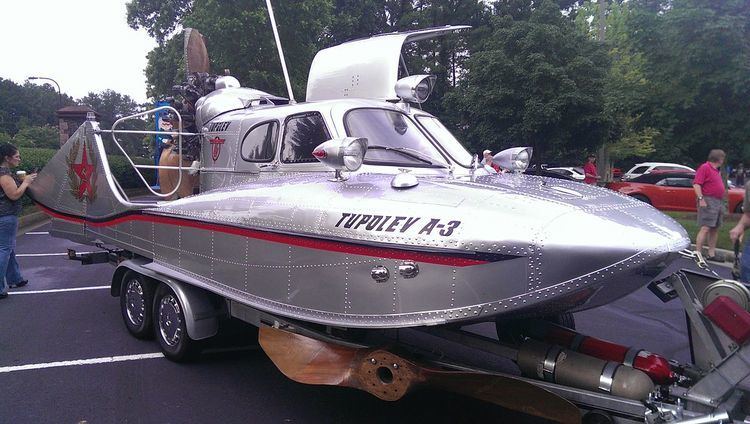Name A-3 Aerosledge Type Aerosled | Builders Tupolev Design Bureau Completed Over 800 Tonnage 1,779 lbs | |
 | ||
The Tupolev A-3 Aerosledge is an all-metal amphibious aerosledge, designed to transport passengers and light freight in remote areas of the Soviet Union. Officially known as the A-3 "Hope" ("Nadezhda" in Russian), it uses a single pusher propeller mounted behind the enclosed cabin to propel the craft over snow or water.
Contents
History
Year-round transportation of mail, passengers, and light freight has always been a problem in remote areas of Siberia and Eastern Europe. Many communities are surrounded by deep snow, hummock ice, marshes that remain unfrozen, and natural waterways choked by weeds. The constantly changing conditions faced by these communities required the development of a vehicle capable of traveling over a widely varied surface at high speeds in order to deliver mail and supplies, as well to transport passengers, and provide emergency medical relief and evacuation to hospitals. To satisfy these requirements, the Tupolev Design Bureau developed an amphibious aerosledge with the appearance of a powered speedboat, and powered by a single radial engine mounted behind the cabin in a pusher position. Development of the A-3 began in 1961, with the first production A-3 being delivered in 1964. Production of the A-3 continued until the early 1980s. Though early production A-3's were manufactured near Moscow, the majority of A-3 production took place in Ukraine, at the Tyachivski Transcarpathian helicopter plant. By the time production ceased in 1983 over 800 A-3 Aerosledges had been produced. Also Nikolay Kamov developed such like the Aerosled K30.
Design
The A-3 Aerosledge has a hull built of riveted metal alloy construction using 2mm D-16T plates and profiles. The craft's ribs, stringers and plates are also of D-16 Duraluminium. Traverse bulkheads divide the craft into three watertight compartments. The craft will remain afloat with one flooded compartment. Double plating is employed for the hull bottom to strengthen it for crossing ice and snow. Low friction 3.5 mm polyethylene is attached to the bottom plates, which is removable for repair. Three stainless-steel runners are mounted to the hull base to provide the craft with the ability to maintain an even course, and prevent side-slipping on ice. The smooth lines of the hull's underside allow it to traverse bodies of water choked with weeds without difficulty. Even with a maximum payload the Aerosledge has a draft of no more than 2 inches. The cabin is fully enclosed with a seating capacity of five in passenger configuration. In standard mail-carrying configuration, the cabin has one swiveling seat for the driver/mail carrier, and a cargo capacity of 1,433 lbs over ice, and 661 lbs over water. Cabin access is by two gull-wing doors. There is an additional baggage storage compartment in front of the cabin, located beneath a hermetically sealed hatch. The craft is controlled by a single wheel connected to twin rudders located behind the propeller. If the wheel is pulled towards the driver both rudders fold outward, forming a brake. If turned and pulled toward the driver only one rudder folds outward, giving greater turning control over water overgrown with reeds or weeds. Three stainless-steel runners mounted along the bottom of the hull provide additional stability while traveling over ice or snow. When traversing snow, the slightly upturned bow of the A-3, together with the differences in pressure between the upper and lower surfaces of the hull, generate an aerodynamic lifting force. At speeds above 50 mph aerodynamic lift reduces the pressure exerted by the craft against the surface by one-third. As the depth of the furrow decreases, friction resistance is reduced accordingly. On water the large area of the lower hull, with its small keel, makes it an ideal shallow-draft watercraft.
Propulsion
The A-3 was originally powered by a 100 hp (75 kW) M-11 five-cylinder air-cooled radial engine. On later models this was replaced by a 260 hp (190 kW) AI-14R radial mounted on a shock-absorbing tubular frame. A removable cowling covers the oil tank and pipes for the lubrication system. The twin fuel tanks are concealed within the hull on either side of the cabin. Fuel caps are located in wells in the deck.
Operation
Used primarily for mail delivery, and to transport essential supplies and medicine, the A-3 was common throughout Eastern Europe, and remote areas of Siberia. A-3's were in service from the mid-1960s until the 1980s.
The A-3 was also used in limited military service, with at least one being based with the Soviet 16th Air Army in East Germany as a rescue craft for downed pilots. Two A3's were also based with the 125 ADIB (fighter-bomber division) at Rechlin. The Hungarian Border Patrol operated four aerosledges at Lake Neusiedl (Lake Neusiedl).
